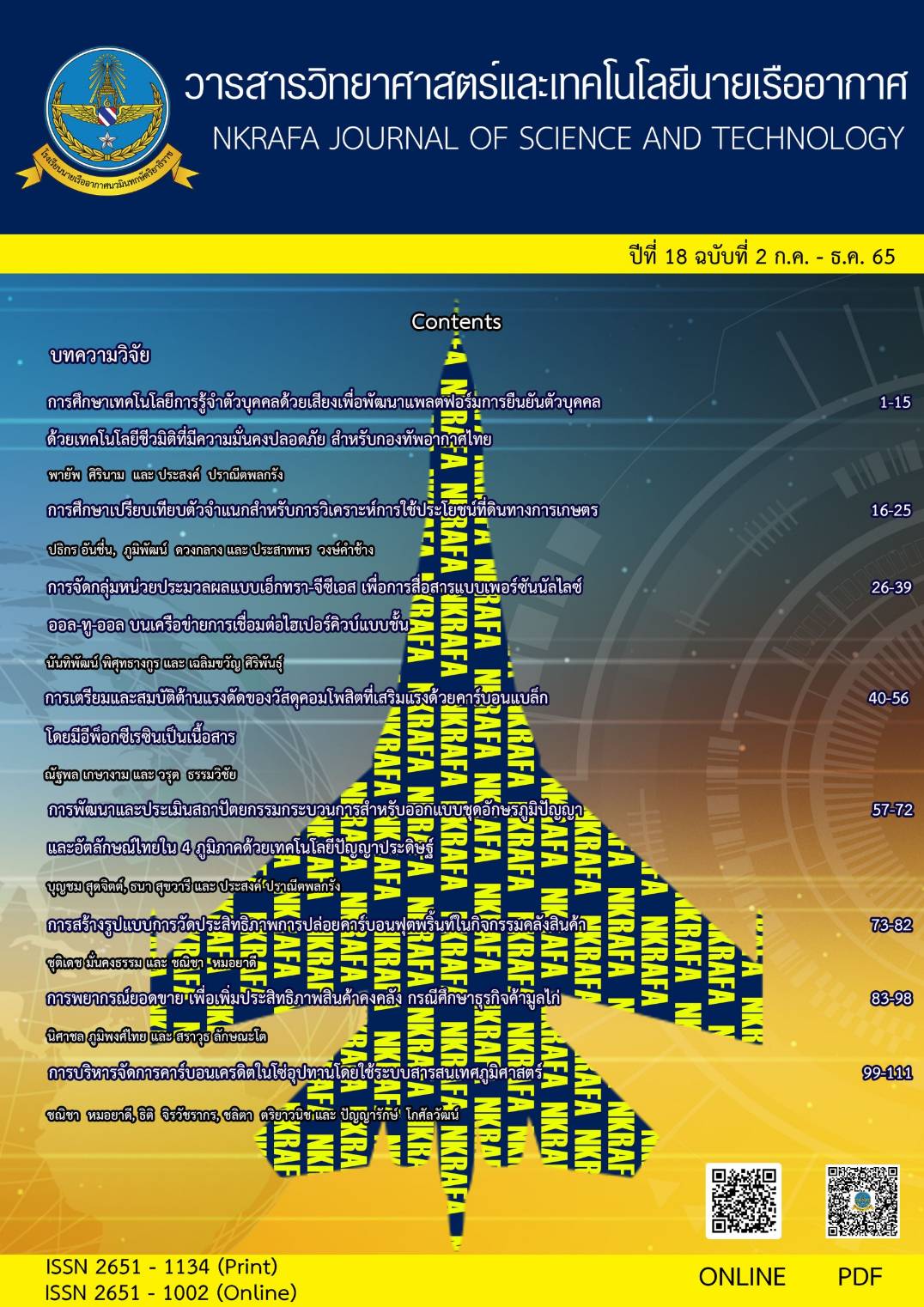The Study of Speaker Recognition Technology to Develop a Secure Biometric Authentication Platform for RTAF
Main Article Content
Abstract
Applications for multi-factor authentication using biometrics are becoming increasingly popular today. However, the Royal Thai Air Force has not implemented biometric technologies for identity verification. For this reason, the research team conducted a study and created a body of knowledge on the use of biometric technologies to identify individuals by their voice. The researchers created a model based on the LibriSpeech dataset and tested it using the Thai voice, as such biometric methods are more accurate, secure, and cost-effective than other biometric methods. The results reveal that environmental elements such as different sentence forms for verification and different types of recording devices are found to significantly affect the performance of the model. In contrast, wearing a mask and other quiet noises do not significantly decrease the performance of the model. Finally, the results also show the model's vulnerability to deep voice spoofing, highlighting the need to develop a model that is resistant to such cyberattacks before it is used in the future.
Article Details

This work is licensed under a Creative Commons Attribution-NonCommercial-NoDerivatives 4.0 International License.
- Content and information in articles published in NKRAFA Journal of Science and Technology are comment and responsibility of authors of articles directly. Journal editorial do no need to agree or share any responsibility.
- NKRAFA Journal of Science and Technology Articles holds the copyright of the content, pictures, images etc. which published in it. If any person or agency require to reuse all or some part of articles, the permission must be obtained from the NKRAFA Journal of Science and Technology.
References
กองทัพอากาศ. (2563). ยุทธศาสตร์กองทัพอากาศ 20 ปี (ฉบับปรับปรุง พ.ศ.2563). สืบค้น 12 มีนาคม 2565,
จาก www.rtaf.mi.th/th/Documents/Publication/RTAF%20Strategy_Final_04122563.pdf
Manikandan, K., & Chandra, E. (2016). Speaker Identification using a Novel Prosody with Fuzzy based Hierarchical
Decision Tree Approach. Indian Journal of Science and Technology. 9: 44.
Dhakal, P., Damacharla, P., Javaid, A. Y., & Devabhaktuni, V. (2019). A Near Real-Time Automatic Speaker Recognition
Architecture for Voice-Based User Interface. Machine Learning and Knowledge Extraction. 1: 504 - 520.
The Math Works, Inc. (1994). Speaker Identification Using Pitch and MFCC. Retrieved on May 5, 2022, from
https://www.mathworks.com/help/audio/ug/speaker-identification-using-pitch-and-mfcc.html
Zaharchuk, G., Gong, E., Wintermark, M., et al. (2018). Deep learning in neuroradiology. AJNR Am J Neuroradiol.
: 1776 - 1784.
Tirumala, S.S., Shahamiri, S. R., Garhwal, A. S., & Wang, R. (2017). Speaker identification features extraction
methods: A systematic review. Expert Systems with Applications. 90: 250 - 271.
พายัพ ศิรินาม. (2562). การพัฒนาโมเดลการเลียนเสียงเชิงลึกสำหรับงานด้านสงครามไซเบอร์ (รายงานผลการวิจัย).
กรุงเทพฯ: โรงเรียนนายเรืออากาศนวมินทกษัตริยาธิราช.
Adrian Rosebrock. (2020). GANs with Keras. Retrieved on May 12, 2022, from https://pyimagesearch.com/
/11/16/gans-with-keras-and-tensorflow/
Vassil Panayotov. (2015). LibriSpeech. Retrieved on June 6, 2022, from https://paperswithcode.com/dataset/librispeech
Ambient Sound TH. (2565). เสียงคนงานกำลังทำงานก่อสร้าง. Retrieved on June 6, 2022, from https://www.youtube.com/
watch?v=3mpmmCqx9fo&ab_channel=AmbientSound%E2%80%8BTH


